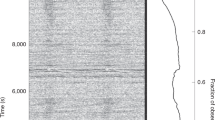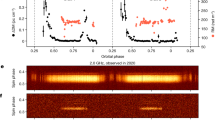MILLISECOND radio pulsars, which are old (∼109yr), rapidly rotating neutron stars believed to be spun up by accretion of matter from their stellar companions, are usually found in binary systems with other degenerate stars1. Using the 305-m Arecibo radiotelescope to make precise timing measurements of pulses from the recently discovered 6.2-ms pulsar PSR1257 +12 (ref. 2), we demonstrate that, rather than being associated with a stellar object, the pulsar is orbited by two or more planet-sized bodies. The planets detected so far have masses of at least 2.8 M⊕ and 3.4 M⊕ where M⊕ is the mass of the Earth. Their respective distances from the pulsar are 0.47 AU and 0.36 AU, and they move in almost circular orbits with periods of 98.2 and 66.6 days. Observations indicate that at least one more planet may be present in this system. The detection of a planetary system around a nearby (∼500 pc), old neutron star, together with the recent report on a planetary companion to the pulsar PSR1829–10 (ref. 3) raises the tantalizing possibility that a non-negligible fraction of neutron stars observable as radio pulsars may be orbited by planet-like bodies.
This is a preview of subscription content, access via your institution
Access options
Subscribe to this journal
Receive 51 print issues and online access
$199.00 per year
only $3.90 per issue
Buy this article
- Purchase on SpringerLink
- Instant access to full article PDF
Prices may be subject to local taxes which are calculated during checkout
Similar content being viewed by others
References
Bhattacharya, D. & van den Heuvel, E. P. J. Phys. Rep. 203, 1–124 (1991).
Wolszczan, A. IAU Circ. No. 5073 (1990).
Bailes, M., Lyne, A. G. & Shemar, S. L. Nature 352, 311–313 (1991).
Wolszczan, A. Nature 350, 688–690 (1991).
Taylor, J. H. & Weisberg, J. M. Astrophys. J. 345, 434–450 (1989).
Davis, M. M., Taylor, J. H., Weisberg, J. M. & Backer, D. C. Nature 315, 547–550 (1985).
Alpar, M. A., Nandkumar, R. & Pines, D. Astrophys. J. 311, 197–213 (1986).
Fruchter, A. S., Stinebring, D. R. & Taylor, J. H. Nature 333, 237–239 (1988).
Lyne, A. G. et al. Nature 347, 650–652 (1990).
Shaham, J. Astrophys. J. 214, 251–260 (1977).
Nelson, R. W., Finn, L. S. & Wasserman, I. Astrophys. J. 348, 226–231 (1990).
Peale, S. J. Ann. Rev. Astr. Astrophys. 14, 215–246 (1976).
Dermott, S. F. & Nicholson, P. D. Nature 319, 115–120 (1986).
Vilas, F. in Mercury (eds Vilas, F., Chapman, C. R. & Matthews, M. S.) 59–76 (University of Arizona Press, Tucson, 1988).
Richards, D. W., Pettengill, G. H., Counselman, C. C. III & Rankin, J. M. Astrophys. J. 160, L1–6 (1970).
Demiański, M. & Pr⊙szyński, M. Nature 282, 383–385 (1979).
Podsiadlowski, Ph., Pringle, J. E. & Rees, M. J. Nature 352, 783–784 (1991).
Fabian, A. C. & Podsiadlowski, Ph. Nature 353, 801–801 (1991).
Lin, D. N. C., Woosley, S. E. & Bodenheimer, P. H. Nature 353, 827–829 (1991).
Krolik, J. H. Nature 353, 829–831 (1991).
Wasserman, I., Cordes, J. M., Finn, L. S. & Nelson, R. W. Cornell Univ. preprint (1991).
Nakano, T. Mon. Not. R. astr. Soc. 224, 107–130 (1987).
Shu, F. H., Lubow, S. H. & Anderson, L. Astrophys. J. 29, 223–241 (1979).
Rudak, B. & Paczyński, B. Acta Astr. 31, 13–24 (1981).
Ryba, M. F. & Taylor, J. H. Astrophys. J. 380, 557–563 (1991).
Black, D. C. Space Sci. Rev. 25, 35–81 (1980).
Author information
Authors and Affiliations
Rights and permissions
About this article
Cite this article
Wolszczan, A., Frail, D. A planetary system around the millisecond pulsar PSR1257 + 12. Nature 355, 145–147 (1992). https://doi.org/10.1038/355145a0
Received:
Accepted:
Issue Date:
DOI: https://doi.org/10.1038/355145a0
This article is cited by
-
Adiabatic theory in Kerr spacetimes
General Relativity and Gravitation (2024)
-
How would we know whether there is life on Earth? This bold experiment found out
Nature (2023)
-
Atmospheric carbon depletion as a tracer of water oceans and biomass on temperate terrestrial exoplanets
Nature Astronomy (2023)
-
Interstellar photovoltaics
Scientific Reports (2023)




